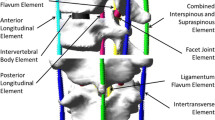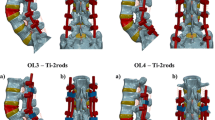Abstract
Purpose
Biomechanical analysis of Ponte (PO) and pedicle subtraction osteotomies (PSO) in kyphotic deformity instrumentation.
Methods
Patient-specific biomechanical model was used to computationally simulate seven hyperkyphotic instrumentation cases with three osteotomy strategies—1-level PSO, 3-level PO, or 6-level PO; forces within the instrumented spine were assessed and results were analyzed through rANOVA tests.
Results
Corrections with multi-level PO were close to those with one-level PSO. In upright position, average implant forces were from 225 to 280 N and rod bending moments were around 10 Nm with no significant difference between the three strategies (p < 0.05). In simulations of 30° flexion, rod bending moments increased by 38, 2, and 8 %, implant forces increased by 28, 23 and 26 % for the 1-level PSO, 3-level PO, and 6-level PO, respectively. Correction per vertebral level was smaller than the maximum correction allowed by PO and PSO.
Conclusions
Multi-level PO allows similar kyphotic correction to 1-level PSO in spinal deformities with mixed indications for PO and PSO. Loads on the instrumentation constructs in PSO were higher than multi-level PO and higher in 6-level PO than 3-level PO. High loads were located more on the osteotomy sites. The rod shape should be adapted to the anticipated spine correction on the osteotomy sites.




Similar content being viewed by others
References
Diab MG, Franzone JM, Vitale MG (2011) The role of posterior spinal osteotomies in pediatric spinal deformity surgery: indications and operative technique. J Pediatr Orthop 31:S88–S98
Diebo B, Liu S, Lafage V, Schwab F (2014) Osteotomies in the treatment of spinal deformities: indications, classification, and surgical planning. European J orthop Surg Traumatol Orthop traumatol 24(Suppl 1):S11–S20
Geck MJ, Macagno A, Ponte A, Shufflebarger HL (2007) The Ponte procedure: posterior only treatment of Scheuermann’s kyphosis using segmental posterior shortening and pedicle screw instrumentation. J Spinal Disord Techniques 20:586–593
Schwab F, Blondel B, Chay E, Demakakos J, Lenke LG, Tropiano P, Ames CP, Smith JS, Shaffrey CI, Glassman S, Farcy JP, Lafage V (2014) The comprehensive anatomical spinal osteotomy classification. Neurosurgery 74:112–120 (discussion 120)
Smith-Petersen MN, Larson CB, Aufranc OE (1945) Osteotomy of the spine for correction of flexion deformity in rheumatoid arthritis. J Bone Joint Surg Am 27:1–11
Bridwell KH (2006) Decision making regarding Smith-Petersen vs. pedicle subtraction osteotomy vs. vertebral column resection for spinal deformity. Spine 31:S171–S178
Smith JS, Sansur CA, Donaldson WF 3rd, Perra JH, Mudiyam R, Choma TJ, Zeller RD, Knapp DR Jr, Noordeen HH, Berven SH, Goytan MJ, Boachie-Adjei O, Shaffrey CI (2011) Short-term morbidity and mortality associated with correction of thoracolumbar fixed sagittal plane deformity: a report from the Scoliosis Research Society Morbidity and Mortality Committee. Spine 36:958–964
Cho KJ, Bridwell KH, Lenke LG, Berra A, Baldus C (2005) Comparison of Smith-Petersen versus pedicle subtraction osteotomy for the correction of fixed sagittal imbalance. Spine 30:2030–2037 (discussion 2038)
Scheer JK, Tang JA, Buckley JM, Deviren V, Pekmezci M, McClellan RT, Ames CP (2011) Biomechanical analysis of osteotomy type and rod diameter for treatment of cervicothoracic kyphosis. Spine 36:E519–E523
Sangiorgio SN, Borkowski SL, Bowen RE, Scaduto AA, Frost NL, Ebramzadeh E (2013) Quantification of increase in three-dimensional spine flexibility following sequential Ponte osteotomies in a cadaveric model. Spine Deformity 1:171–178
Charosky S, Moreno P, Maxy P (2014) Instability and instrumentation failures after a PSO: a finite element analysis. Eur Spine J 23(11):2340–2349
Kadoury S, Cheriet F, Laporte C, Labelle H (2007) A versatile 3D reconstruction system of the spine and pelvis for clinical assessment of spinal deformities. Med Biol Eng Compu 45:591–602
Aubin CE, Labelle H, Chevrefils C, Desroches G, Clin J, Boivin A (2008) Preoperative planning simulator for spinal deformity surgeries. Spine 33:2143–2152
Anderson AL, McIff TE, Asher MA, Burton DC, Glattes RC (2009) The effect of posterior thoracic spine anatomical structures on motion segment flexion stiffness. Spine 34:441–446
Gardner-Morse MG, Stokes IA (2004) Structural behavior of human lumbar spinal motion segments. J Biomech 37:205–212
Oda I, Abumi K, Cunningham BW, Kaneda K, McAfee PC (2002) An in vitro human cadaveric study investigating the biomechanical properties of the thoracic spine. Spine 27:E64–E70
Panjabi MM, Brand RA Jr, White AA 3rd (1976) Three-dimensional flexibility and stiffness properties of the human thoracic spine. J Biomech 9:185–192
Pearsall DJ, Reid JG, Livingston LA (1996) Segmental inertial parameters of the human trunk as determined from computed tomography. Ann Biomed Eng 24:198–210
Rohlmann A, Bauer L, Zander T, Bergmann G, Wilke HJ (2006) Determination of trunk muscle forces for flexion and extension by using a validated finite element model of the lumbar spine and measured in vivo data. J Biomech 39:981–989
Rohlmann A, Zander T, Rao M, Bergmann G (2009) Realistic loading conditions for upper body bending. J Biomech 42:884–890
Wilke HJ, Rohlmann A, Neller S, Graichen F, Claes L, Bergmann G (2003) ISSLS prize winner: a novel approach to determine trunk muscle forces during flexion and extension: a comparison of data from an in vitro experiment and in vivo measurements. Spine 28:2585–2593
Kiefer A, Shirazi-Adl A, Parnianpour M (1997) Stability of the human spine in neutral postures. European Spine J Off Publ European Spine Soc European Spinal Deformity Soc European Sect Cerv Spine Res Soc 6:45–53
Watkins J (2007) An introduction to biomechanics of sport and exercise. Churchill Livingstone, london
Carman DL, Browne RH, Birch JG (1990) Measurement of scoliosis and kyphosis radiographs. Intraobserver and interobserver variation. J Bone Joint Surg Am 72:328–333
Berjano P, Bassani R, Casero G, Sinigaglia A, Cecchinato R, Lamartina C (2013) Failures and revisions in surgery for sagittal imbalance: analysis of factors influencing failure. European Spine J Off Publ European Spine Soc European Spinal Deformity Soc European Sect Cerv Spine Res Soc 22(Suppl 6):S853–S858
Johnston CE, Elerson E, Dagher G (2005) Correction of adolescent hyperkyphosis with posterior-only threaded rod compression instrumentation: is anterior spinal fusion still necessary? Spine 30:1528–1534
Smith JS, Shaffrey CI, Ames CP, Demakakos J, Fu KM, Keshavarzi S, Li CM, Deviren V, Schwab F, Lafage V, Bess S, International Spine Study G (2012) Assessment of symptomatic rod fracture after posterior instrumented fusion for adult spinal deformity. Neurosurgery 71:862–867
Acknowledgments
This study was financially supported by the Natural Sciences and Engineering Research Council of Canada and a research support from Medtronic.
Author information
Authors and Affiliations
Corresponding author
Ethics declarations
Conflict of interest
None of the authors has any potential conflict of interest.
Rights and permissions
About this article
Cite this article
Salvi, G., Aubin, CE., Le Naveaux, F. et al. Biomechanical analysis of Ponte and pedicle subtraction osteotomies for the surgical correction of kyphotic deformities. Eur Spine J 25, 2452–2460 (2016). https://doi.org/10.1007/s00586-015-4279-1
Received:
Revised:
Accepted:
Published:
Issue Date:
DOI: https://doi.org/10.1007/s00586-015-4279-1




